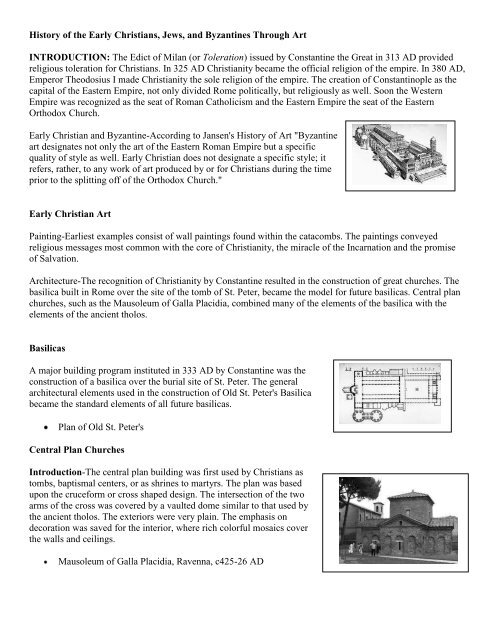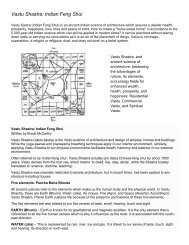Early Christians, Jews, Byzantine notes.pdf - DMHScommunity
Early Christians, Jews, Byzantine notes.pdf - DMHScommunity
Early Christians, Jews, Byzantine notes.pdf - DMHScommunity
Create successful ePaper yourself
Turn your PDF publications into a flip-book with our unique Google optimized e-Paper software.
History of the <strong>Early</strong> <strong>Christians</strong>, <strong>Jews</strong>, and <strong>Byzantine</strong>s Through Art<br />
INTRODUCTION: The Edict of Milan (or Toleration) issued by Constantine the Great in 313 AD provided<br />
religious toleration for <strong>Christians</strong>. In 325 AD Christianity became the official religion of the empire. In 380 AD,<br />
Emperor Theodosius I made Christianity the sole religion of the empire. The creation of Constantinople as the<br />
capital of the Eastern Empire, not only divided Rome politically, but religiously as well. Soon the Western<br />
Empire was recognized as the seat of Roman Catholicism and the Eastern Empire the seat of the Eastern<br />
Orthodox Church.<br />
<strong>Early</strong> Christian and <strong>Byzantine</strong>-According to Jansen's History of Art "<strong>Byzantine</strong><br />
art designates not only the art of the Eastern Roman Empire but a specific<br />
quality of style as well. <strong>Early</strong> Christian does not designate a specific style; it<br />
refers, rather, to any work of art produced by or for <strong>Christians</strong> during the time<br />
prior to the splitting off of the Orthodox Church."<br />
<strong>Early</strong> Christian Art<br />
Painting-Earliest examples consist of wall paintings found within the catacombs. The paintings conveyed<br />
religious messages most common with the core of Christianity, the miracle of the Incarnation and the promise<br />
of Salvation.<br />
Architecture-The recognition of Christianity by Constantine resulted in the construction of great churches. The<br />
basilica built in Rome over the site of the tomb of St. Peter, became the model for future basilicas. Central plan<br />
churches, such as the Mausoleum of Galla Placidia, combined many of the elements of the basilica with the<br />
elements of the ancient tholos.<br />
Basilicas<br />
A major building program instituted in 333 AD by Constantine was the<br />
construction of a basilica over the burial site of St. Peter. The general<br />
architectural elements used in the construction of Old St. Peter's Basilica<br />
became the standard elements of all future basilicas.<br />
Plan of Old St. Peter's<br />
Central Plan Churches<br />
Introduction-The central plan building was first used by <strong>Christians</strong> as<br />
tombs, baptismal centers, or as shrines to martyrs. The plan was based<br />
upon the cruceform or cross shaped design. The intersection of the two<br />
arms of the cross was covered by a vaulted dome similar to that used by<br />
the ancient tholos. The exteriors were very plain. The emphasis on<br />
decoration was saved for the interior, where rich colorful mosaics cover<br />
the walls and ceilings.<br />
Mausoleum of Galla Placidia, Ravenna, c425-26 AD
Mosaics-The large all surfaces on the interior of the newly built churches were left to the artists for decoration.<br />
Great pictorial cycles were designed by master craftmen. Brilliantly colored tesserae created mosaics that<br />
advertised the new religion as well instructed the worshippers in<br />
the basic doctrines of the faith.<br />
Good Shephard, lunette over west entrance, Galla<br />
Placidia<br />
Martyrdom of Saint Lawrence, lunette over eastern bay,<br />
Galla Placidia<br />
Saint Apollinaris, First Bishop of Ravenna, apse of<br />
Sant'Apollinare Nuovo<br />
<strong>Byzantine</strong> Art<br />
Introduction- The <strong>Byzantine</strong> Empire existed for more than a thousand years (from approximately 306 AD to<br />
1453 AD). There were no clear-cut lines between <strong>Early</strong> Christian and early <strong>Byzantine</strong> art until the 5th century.<br />
By then, certain stylistic differences were evident. True <strong>Byzantine</strong> art stylistically began 500 AD and lasted<br />
until 730 AD. It included the reign of Justinian to the Iconoclasm (Greek for "image-breaking").<br />
Architecture-The most important structure from the Golden Age of <strong>Byzantine</strong> Art was the construction of<br />
Hagia Sophia in Constantinople by Emperor Justinian. Justinian hired two well known architects for the project,<br />
Anthemius of Tralles and Isidorius of Miletus. In addition to Hagia Sopia, the construction of San Vitale and<br />
Sant'Apollinare Nuovo, in Ravenna, Italy illustrate the resurrection of the Western Empire under Justinian's<br />
rule.<br />
Mosaics<br />
Hagia Sophia, Instanbul, 532-537 AD<br />
plan of Hagia Sophia, Instanbul, 532-537 AD<br />
San Vitale, in Classe, Ravenna, 526-547 AD<br />
Sant'Apollinare Nuovo, Ravenna, 533-549 AD<br />
Saint Apollinaris, First Bishop of Ravenna, apse of<br />
Sant'Apollinare Nuovo<br />
The Second Coming (Christ Between Angels and Saints), apse of San Vitale<br />
Justinian and His Attendants, north wall of apse, San Vitale<br />
Theodora and Her Attendants, south wall of apse, San Vitale<br />
Icons and Manuscript Illumination<br />
Virgin and Child With Saints, c75-50 BCE<br />
Vladimir Madonna, late second or early first century BCE<br />
Old Testament Trinity, 13-9 BCE<br />
The Crucifixion, 13-9 BCE<br />
The Ascension, 13-9 BCE
















